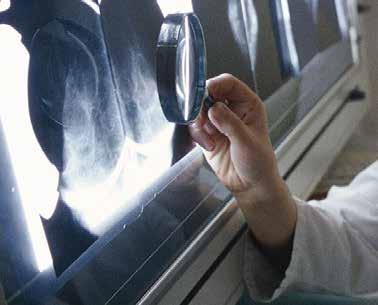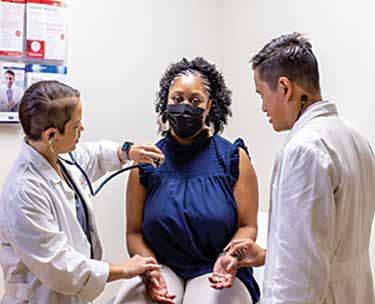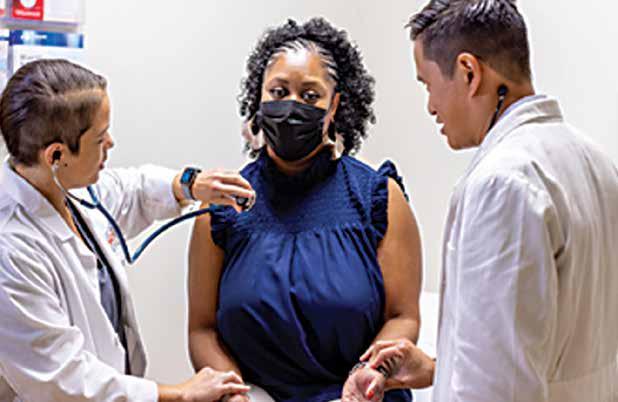INDEX
Oncology Research pg.3
Healthy Heart pg.7 The Framework pg.8
Financial Forecast pg.11

Oncology Research pg.3
Healthy Heart pg.7 The Framework pg.8
Financial Forecast pg.11



 By
By
Hospitals and medical staffs are highly regulated organizations with a myriad of laws and standards that must be followed. Medical staff leaders, advisors or medical staff professionals are responsible for leading and advising the professionals who are responsible for practitioner competence and conduct within the organization. As the year-end approaches, it is a good time for these individuals to evaluate the effectiveness of the peer review process and reflect on the related protections and obligations.
Below are five recommendations for a medical staff organization’s year-end review and reflection.

1. Update Governance Documents to Reflect Actual Practice. Governance documents include the medical staff bylaws, credentialing manual, hearing plan, rules and regulations, policies and other documents approved by the medical staff and designed to set and guide medical staff processes. Too often these documents will conflict or omit critical passages. All governance documents should be reviewed in the context of the laws and regulations that require these documents. State and federal laws and regulations set out the basic requirements for the contents of the documents, as do many of the accreditation standards. It is far
better to review and revise your governance documents regularly, rather than learn they are deficient during an unannounced survey or regulatory proceeding.
scope of your authority, but report your actions to the committee/ department on a regular basis and be sure your actions are properly recorded in the appropriate minutes. If summary or urgent action is needed, do not hesitate to call a special meeting. You are better off to have the protection of a committee action than to be acting alone or without ratification.
2. Know the Scope of Your Authority.
Medical staff bylaws generally identify the circumstances under which you can act alone and when your action(s) will need to be ratified by the committee. As the chair, you are acting on behalf of the committee/ department between meetings. Do what is needed when needed, within the
3. 3. Know the Peer Review Protections of HCQIA, Texas and Organization. The Healthcare Quality Improvement Act (“HCQIA”) provides protection from liability for members of a professional review body/ medical staff, who take a professional review action (a) in the reasonable belief the action was in furtherance of quality health care, (b) after a
Medical staff organizations serve a very important role. Regularly reviewing governance documents and legal protections are vital to promoting and maintaining quality health care within an organization.
Sherri T. Alexander, J.D. Erin Muellenberg, J.D. Polsinelli, PC

celebration look a little different this year.
There’s no “wrong” way to celebrate Cancer can throw many wrenches into the holidays, from financial hardships and canceled travel arrangements, to missing your child’s holiday performances or school events.
Tidings of comfort and joy can take on a different meaning during the holidays as a cancer patient. Some may not feel much like celebrating, especially if you’re a parent with cancer. Adding holiday season pressures and the challenge of fighting cancer to the everyday stress of parenting can be overwhelming.
With so much focus needed to manage your diagnosis and the effects of cancer and treatment, it may be hard or even impossible to maintain some of your family’s beloved holiday traditions. However, it is still possible to have a meaningful and joyful holiday with the ones you love, perhaps with some small adjustments that may make your family
As you navigate these twists and turns, it is important to keep in mind that there is no wrong or right way to celebrate the holidays when you are newly diagnosed with cancer or undergoing treatment. Do what feels right for you and your loved ones, finding joy in the happy moments. While tried and true holiday traditions are special, there is nothing wrong with starting new ones.
Children may be worried about their parent’s health or upset about changes to ‘normal’ family experiences, even more so at the holidays. As a parent with cancer, it is important to talk to your children and be honest,
albeit age appropriate, in explaining the potential changes that will affect them.
In a calm and reassuring tone, set expectations about your ability to run around town or participate in holiday activities. This can help alleviate the anxiety and uncertainty children may feel.
Let your children know when you aren’t feeling well but that you love them the same as always, no matter what. Being candid enables your children to ask questions and feel comfortable expressing their own feelings.
Five tips for parenting with cancer at the holidays
1. Plan together with your children.
Think about the types of things your children can do to help during the holidays. This can contribute to their sense of purpose and closeness to you.

2. Have backup plans in place and ask for help. Reach out to friends or family if you are not feeling well enough to drive your children to a holiday event. Ask someone to record your child’s performance in holiday productions if you can’t attend in person.

3. Incorporate technology. Take advantage of technology to bridge the distance with extended family and friends. Just because you aren’t

Dr. Douglas Dirschl has been named chair of the Joseph Barnhart Department of Orthopedic Surgery at Baylor College of Medicine, effective April 1, 2023.

Dirschl joins Baylor after serving since 2013 as the Lowell T. Coggeshall Professor and chairman of the Department of Orthopaedic Surgery and Rehabilitation Medicine and physician-in-chief of the musculoskeletal service line at the University of Chicago Medicine and Biological Sciences. Prior to that, Dirschl served for 10 years as the chairman of the Department of Orthopaedics at the University of North Carolina School of Medicine, where he spent the bulk of his academic career. He is nationally known as an academic leader, educator, fracture
knowledge and experience in the field of orthopedics as well as in healthcare leadership makes him the ideal candidate for this position,” said Dr. Paul Klotman, president, CEO and executive dean of Baylor.
Dirschl has received numerous accolades and awards during his career and served in many roles at the American Orthopaedic Association, including as president from 2011-2012. He was honored as an ABC Traveling Fellow in 2001, an honor provided to five U.S. orthopedic surgeons every two years, and was a founding member of the American Orthopaedic Association’s Own the Bone Program.
He also is a member of the American Academy of Orthopaedic Surgeons, the Orthopaedic Trauma Association and the Foundation for Orthopaedic




the American Board of Orthopaedic Surgery.


He earned his undergraduate degree from Stanford University in chemical engineering and received his medical degree cum laude from Oregon Health Sciences University. He completed his residency in orthopedic surgery at the University of North Carolina at Chapel Hill. Dirschl specializes in orthopedic traumatology, infections of bone and fragility fractures and bone health. His research interests include bone health, evaluating and improving the reliability of classification systems, imaging processing and neural networks and tissue engineering for fracture healing and management of bone infection.
“I am honored to be joining Baylor College of Medicine, an institution with boundless potential
forward to partnering with Baylor, its faculty and its hospital affiliates to help elevate orthopedic surgery to the top tier of academic orthopedic programs nationally.”
Dirschl succeeds Dr. William Granberry, who served as interim chair of the department.

Aresearcher at the University of Houston College of Pharmacy is reporting an effective protocol for reprogramming human heart cells into specialized cells that conduct electricity throughout the heart to enable rhythmic heartbeat and repair diseased hearts. Bradley McConnell, professor of pharmacology, is the first to demonstrate the process and is reporting it in iScience.
It could be a massive breakthrough.
Currently, there are no treatments for cardiac cell death, the underlying basis of cardiovascular disease (CVD), which remains the leading cause of death globally. By 2035, CVD prevalence is expected to increase to 45.1% (more than 130
million people) in the U.S. while the financial cost is projected to increase by more than $131 million over the next two decades, reaching an astounding $1.1 trillion.

McConnell examined an alternative and unexplored cell type in cardiac regeneration - the cardiac Purkinje cells – which are specialized cells from the cardiac conduction system (CCS) responsible for electrical signals that enable the heart to contract and relax synchronously.
The results indicate that it may restore the efficiency of electrical signal conduction, resulting in improvements in cardiac function.
“We are the first to demonstrate the successful direct reprogramming of human cardiomyocyte cell lines (AC16-CMs and iPSC-CMs) into
Purkinje-like cells using a unique cocktail of small molecules,” reports both McConnell and the first author of the study, Nicole Prodan, a doctoral student while in the McConnel lab. “Direct reprogramming is a technique that produces an epigenetically unstable “plastic” state on the cells to facilitate the conversion of a fully differentiated and matured cell into a different new cell type.”
While several pharmacological treatments are currently available for heart failure, they do not prevent, cure or improve myocardial cell death and fibrotic scar formation, which are the main contributors to provoking heart failure.
“The only cure is a heart transplant, which is unfortunately scarce,” said McConnell.
Cell therapy for cardiac regeneration has been proposed as an alternative treatment to pharmacological agents. Unfortunately, so far, the focus has been placed on replacing cardiac muscle cells (myocytes) in injured hearts, which has not been enough to ameliorate symptoms or cure the problem.
“This is because often the cardiac myocytes implanted cannot be electrically activated in synchrony by the recipient’s heart and will contract

Every fall and winter, viral respiratory illnesses like the common cold and seasonal flu keep kids out of school and social activities. But this year, more children than usual are ending up at emergency departments and hospitals.
In California, the Orange County health department declared a state of emergency in early November 2022 due to record numbers of pediatric hospitalizations for respiratory infections. In Maryland, emergency rooms have run out of beds because of the unusually high number of severe respiratory syncytial virus, or RSV, infections. So emergency departments there are having to refer patients across state lines for care.
In the U.S., the winter respiratory virus season started earlier than usual
this year. Since peak infections usually occur in late December or January, this uncharacteristic early wave suggests that the situation could get much worse for people of all ages, particularly children.
We are epidemiologists with expertise in epidemic analysis for emerging disease threats, including respiratory infections. We watch patterns in these infections closely, and we pay particular attention when the patterns are unusual. We’ve grown increasingly concerned about the amount of pediatric hospitalizations over the last few months and the pattern that is emerging. The ‘triple threat’

In early November, the Centers for Disease Control and Prevention (CDC) issued a health advisory about increased activity in respiratory

infections—especially among children. The CDC and other health experts are warning of the so-called “triple threat” of respiratory illness from RSV, influenza—or the seasonal flu— and COVID-19.
The underlying reasons for the convergence of these viruses and the increase in infections so early in the season are not yet clear. But health experts have some clues about contributing factors and what it could mean for the coming months.
When it comes to COVID-19, 2022 is expected to usher in another winter wave of infections, similar to patterns seen in 2020 and 2021. Previous winter surges stemmed from a combination of factors, including the emergence and spread of new viral variants, more people gathering indoors rather than distanced outside, and people coming together for the holidays.

But unlike previous pandemic winters, most COVID-19 precautions— such as using masks in public areas or avoiding group activities—are more relaxed than ever. Together with the looming threat of new variants, it is difficult to predict how big the next

COVID-19 wave could be.
And while the seasonal flu has proved somewhat unpredictable during the COVID-19 pandemic, it nearly always hits during late October. Flu season also arrived about a month early and in greater numbers than in recent history. By our read of the data, pediatric flu hospitalizations are nearing 10 times what has been seen for this time of year for more than a decade.
RSV infections tend to follow a similar seasonal pattern as the flu, peaking in winter months. But this year, there was an unexpected summer wave, well before the start of the typical fall respiratory virus season.
In typical years, RSV garners little media attention. It’s incredibly common and usually causes only mild



Scientific research over time has shown an uptick in cardiac events during the winter holiday season, and more people die from heart attacks between December 25th and January 1st than at any other time of the year.
The American Heart Association, the world’s leading nonprofit organization focused on heart and brain health for all, has tips and resources to help you and yours have a happy, healthy holiday season.
“The holidays are a busy, often stressful time for most of us. Routines are disrupted. We may tend to eat and drink more, and exercise and relax less. We also may not be listening to our bodies or paying attention to warning signs, thinking it can wait until after the new year. All of these can be contributors to increasing the risk for heart attack,” said Erin Asprec, Executive Vice President and Chief Operating Officer of Memorial
Hermann Health System and the 2022 Houston Go Red for Women Chair. “This may be even more likely for many people who didn’t get to be with family and friends last year due to COVID-19 restrictions. But by taking just a few simple steps, you can ensure you’re keeping your heart healthy so there is much to celebrate in the new year.”
Here are some things to be mindful of (a list we recommend checking twice):
• Know the symptoms and take action: Heart attack signs may vary in men and women and it’s important to catch them early and call 9-1-1 for help. The sooner medical treatment begins, the better the chances of survival and preventing heart damage.

• Celebrate in moderation: ‘Tis the season for unhealthy changes in diet and higher alcohol consumption. Eating healthfully during the holidays doesn’t have
to mean depriving yourself, there are still ways to eat smart. Look for small, healthy changes and swaps you can make so you continue to feel your best while eating and drinking in moderation, and don’t forget to watch the sodium.
• Plan for peace on earth and goodwill toward yourself: Make time to take care of yourself during the busy holiday. Reduce stress from family interactions, strained finances, hectic schedules and other stressors that tack on this time of year, including traveling.
• Keep moving: The American Heart Association recommends at least 150 minutes of physical

activity per week and this number usually drops during the holiday buzz. Get creative with ways to stay active, even if it’s going for a family walk or another fun activity you can do with your loved ones.
• Stick to your meds: Busy holidays can make way for skipping medications, forgetting them when away from home, or not getting refills in a timely manner. Here is a medication chart to help stay on top of it and be sure to keep tabs on your blood pressure numbers. For more information visit heart.org.

Houston Methodist Baytown officially opens a new five-story building to patients today. The new state-of-the-art tower is named Unity Tower and features 75 private rooms, an intensive care unit, and an entire floor dedicated to childbirth and obstetrics services.

“This is an exciting time for Houston Methodist Baytown Hospital, our staff, physicians and the community,” said Chief Executive Office David Bernard. “I am proud to expand the hospital and our services so that we can better serve the community that has supported us for nearly 75 years.”
The Unity Tower project includes vital infrastructure,

including a new pharmacy, expanded laboratory, hospital kitchen, dialysis unit and many other clinical enhancements to serve our patients.
Unity Tower is part of a $250 million facilities master plan that started in 2017 and includes the new and expanded emergency department, outpatient center, Houston Methodist Neal


Dr. Winston Liaw, chair of the Health Systems and Population Health Sciences department at the Tilman J. Fertitta Family College of Medicine, and third-year medical student Sarah Snyder examine a patient in the Family Care Center. chair of the Health Systems and Population Health Sciences department
The UH Health Family Care Center, a new on-campus health clinic that provides affordable, comprehensive and integrated primary care and mental health services to the University of Houston community and surrounding neighborhoods, is now open and accepting new patients.
Staffed by faculty physicians and psychologists from the Tilman J. Fertitta Family College of Medicine, the center expands access to health care for underserved communities including the Third Ward and East End. These areas experience some of the highest rates of chronic disease,

such as diabetes and hypertension, in Harris County.
More broadly, Texas is one of the worst states in the nation when it comes to health disparities, according to a study from the Commonwealth Fund. Blacks and Latinos, in particular, lack access to quality, preventative care and are more likely to have treatments delayed. The Family Care Center aims to change that trend.
“No matter your zip code, everyone deserves access to high-quality, affordable health care,” said Dr. Stephen Spann, founding dean of the Fertitta Family College of Medicine and a clinic physician. “We are providing coordinated, patient-centered care that will help address these longstanding health disparities.”
The Family Care Center features an innovative, integrated behavioral health model of care that allows for comprehensive primary care without neglecting the mental health needs of patients. The clinic offers pediatric and
adult care, women’s health care, mental health services as well as outpatient psychological and psychiatric consultation services.
“This model, which allows for whole person care and helps reduce the stigma associated with seeking help for mental health, is something that sets us apart from other clinics,” said Dr. Brian Reed, professor and chair of the Department of Clinical Sciences at the Fertitta Family College of Medicine and practicing clinic physician. “It’s basically a one-stop shop for all of your health needs.”
The center is located in the University of Houston’s Health 2 building at 4349 Martin Luther King, Jr. Boulevard, suite 1001E. Most major insurance plans, including Medicare, are accepted. For patients without insurance, a sliding fee discount program (SFDP) is available based on income and household size. Same-day and next-day appointments are available and walk-in patients are welcome. Bi-lingual providers are
available.
“We want to be a valuable resource and provide the highest quality health care to all members of our community, whether they have insurance or not,” said Danielle Brownlie, senior director of clinic operations. “We provide opportunities for anyone to be seen here.”
The clinic also provides UH medical students with real-time training in communities they will potentially serve in the future. The Fertitta Family College of Medicine opened in 2020 on a distinct social mission to improve health and health care in underserved urban and rural communities where poor health outcomes are often more
Afirst responder for almost four decades, Roger McCurley had made hundreds of hospital runs while providing emergency service to people in the midst of the worst days of their lives. When the retired Flower Mound firefighter needed expert medical help himself, he was referred to urinary surgeons at UT Southwestern Medical Center.

“When I retired in 2017 after 38 years, my only experience with hospitals was taking other patients there,” Mr. McCurley says. “As a firefighter, we had regular checkups and bloodwork done. But I let it lapse for a couple of years and my PSA went from a 3 to a 7.2.”
The resident of Northlake, west of Dallas, underwent surgery at UTSW in 2020 for aggressive prostate cancer,
as a team removed lesion-riddled glands along with some surrounding tissue and nerves. The procedure, while successful in eradicating the disease, left Mr. McCurley with urinary incontinence that soaked three to six pads a day.
In February 2021, Mr. McCurley again came to UT Southwestern’s William P. Clements Jr. University Hospital, this time for Steven Hudak, M.D., to surgically implant an artificial urinary sphincter (AUS) to alleviate urinary leakage. The AUS, which typically can provide relief for a decade or more, is a small, fluid-filled ring that goes around the urethra, just downstream from the native sphincter. Inflated, it prevents flow. Deflated with the press of a button, it relieves urine
accumulation by allowing the patient to urinate normally.
“I’ve been a happy camper since the surgery. You don’t even know it’s there. As long as I’m careful and make sure the cuff inflates afterward, I don’t have any issues,” Mr. McCurley says.
“The AUS surgery to correct his urinary incontinence has improved his quality of life,” says Dr. Hudak, an Associate Professor of Urology and UTSW faculty member since 2019. “His positive outlook and high satisfaction thoroughly impressed me.”
Since his surgeries, Mr. McCurley has returned to many of his regular activities and also has taken part in some of the research at UT Southwestern that helped determine the likely cause of his cancer.
“I was happy to take part in a clinical trial, as the firefighting community has become much more aware of the threat of cancer in the past few years,” Mr. McCurley says. “My younger brother, who’s also a firefighter, also has had prostate cancer.”
The Centers for Disease Control and Prevention reports that aside from non-melanoma skin cancer, prostate cancer is the most common cancer
among men in the United States. In 2019, the latest reportable year and about the time Mr. McCurley was diagnosed, there were 224,733 new cases in the U.S. and 31,636 deaths.
Approximately 10% of men treated for prostate cancer will undergo surgery to correct urinary incontinence, with only a minority of





As we emerge from the COVID-19 pandemic, there seems to be a new travel trend. We used to save vacations for summertime, but we now see people traveling more at off-peak season. This is because most people now have more flexibility in their schedules, thanks in large part to the trend of working remotely that arose during COVID.
If you and your significant other are planning a trip to get away before or after family time during the holidays,
warm southern locales to knock off the winter chill. Or you could visit the ski slopes at this time, when crowds tend to be smaller.
With so many people working remotely now, it can be somewhat easier to take time off to travel. You could even bring your laptop with you and knock out some work projects while taking in a scenic view.

Vacations can be costly especially when factoring in transportation, lodging and meals. So planning is a must. Here are the key items to consider:
• Determine the maximum amount of money you want to spend. Your travel budget
here are some things to consider.
Seasonal deals after Labor Day and before Christmas have been increasing. This is because of the cooler weather, and fewer people tend to travel then. So, prices also tend to be lower and there are fewer lines and crowds. Saving time is part of saving money. And private time with your mate is priceless.
Many couples want to go to Europe for a romantic getaway. For example, Thanksgiving week is a good time for these types of trips, because overseas countries don’t celebrate Thanksgiving, so most attractions are open. Plus, things are slower here in the U.S., so work may not be as hectic.

For something domestic, January and February can be great times to visit
will depend largely on where you go and what you plan to do. For instance, going to an international destination will likely cost more than heading to a beach or campground here in the U.S. Likewise, lodging in larger cities tends to be higher-priced than in rural areas. The timing of your trip can also be a motivator in terms of expenses. In this case, travel at off-peak times could land you discounts on lodging and attractions.
• Start saving now, even if the trip won’t take place for some time. After you have an approximate dollar amount in mind for the cost of your trip, you can break
For patients with estrogen receptor (ER)-positive breast cancer, development of the so-called Y537S mutation signals that their disease has taken an aggressive course and may become resistant to endocrine therapy. Now a preclinical study, led by researchers at UT Southwestern Medical Center, suggests that a class of new drugs already in clinical trials might work especially well in breast cancer patients who have acquired this mutation.
“Identifying drugs that selectively target this highly aggressive mutation has been elusive,” said Prasanna Alluri, M.D., Ph.D., Assistant Professor of Radiation Oncology, a member of UTSW’s Harold C. Simmons Comprehensive Cancer Center, and senior author of the study published in JCI Insight. “Now we have uncovered a new therapeutic vulnerability in breast cancers that have developed resistance to endocrine therapy through acquisition of the Y537S mutation. When used early, this drug

may prevent or delay development of endocrine therapy resistance by blocking an increase in the proportion of cells harboring the Y537S mutation.”
In the U.S., over 250,000 patients are diagnosed with breast cancer each year. About 75% of breast cancers are ER-positive, meaning that the growth of these tumor cells is fueled by the binding of estrogen to the estrogen receptor protein in the cytoplasm. This binding results in the ER protein entering the nucleus and altering the on/off status of many genes, stimulating growth of the tumor.
To combat this, patients receive endocrine therapy drugs that block ER function. These drugs usually work well for a time, but in most patients with metastatic breast cancer, tumor cells often develop mutations that allow them to circumvent the drug’s effects and continue growing. A common mutation, dubbed Y537S, causes a high degree of resistance to endocrine therapy.
By testing over 1,200 existing


drugs or drug candidates against breast cancer cells, UT Southwestern researchers identified a BET inhibitor called OTX015 that significantly suppressed the growth of breast cancer cells – especially those carrying the Y537S mutation. Two other BET inhibitors also showed higher selectivity toward Y537S cells. BET proteins are known to enhance the activity of many genes that drive the proliferation of cancer cells, making them an attractive target for cancer drugs.
OTX015 also showed high effectiveness in inhibiting the growth of tumors harboring the Y537S mutations when implanted in mice. Furthermore, when combined with abemaciclib, a clinically approved drug used to treat breast cancer patients, OTX015 showed higher efficacy in inhibiting tumor growth than the existing standard-of-care treatment.
“Our mouse studies showed that OTX015 plus abemaciclib caused 50% greater tumor reduction than fulvestrant plus abemaciclib,” said Dr. Alluri.
According to Dr. Alluri, there are several BET inhibitors in early-stage clinical trials, including OTX015,
which was shown to be safe in a phase 1 trial.
“This new data can guide the design of BET inhibitor trials by identifying patients who are more likely to respond to this promising treatment. Our study also uncovers promising BET inhibitor combination treatments, which can also be further validated in future clinical trials in breast cancer patients,” said Dr. Alluri. “Our hope is that such trials will lead to improvements in both the prevention and treatment of endocrine therapy resistance in patients with breast cancer.”
Continued from page 6
illness. In fact, most children encounter the virus before age 2.
But RSV can be a formidable respiratory infection with serious consequences for children under 5, especially infants. It is the most common cause of lower respiratory infections in young children, and more severe illnesses can lead to pneumonia and other complications, often requiring hospitalization.
Why children are particularly at risk
Children, especially young children, tend to get sicker from flu and RSV than other age groups. But infants younger than 6 months old stand to suffer the most, with nearly double the risk of RSV-related death compared to other children younger than 5. COVID-19 hospitalization rates are also four to five times higher for infants than older children.
One reason the youngest children are at greater risk is that their immune systems are not yet fully developed and don’t produce the robust immune response seen in most adults. What’s more, infants younger than 6 months—who are most at
Continued from page 8
Cancer Center at Baytown facility, parking garage, central utility plant and numerous infrastructure enhancements.
Continued from page 11
that down and save monthly until you reach your goal. You could also beef up your travel account if you receive a bonus at work and/or an
Continued from page 9
prevalent. Students are trained to provide compassionate, high-value care (high quality at reasonable cost), with a focus on primary care and other needed physician specialties.
“The education of the next generation of health care professionals is at the core of our mission, so the Family Care Center is an important site for our students to engage with patients and develop their clinical skills,” said Reed.
Access to a health care home is the
risk of severe disease—are still too young to be vaccinated against influenza or COVID-19.
These viruses present challenges on their own, but their co-circulation and coinciding surges in infections create a perfect storm for multiple viruses to infect the same person at once. Viruses might even act together to evade immunity and cause damage to the respiratory tract.
Such co-infections are typically uncommon. However, the likelihood of co-infection is substantially higher for children than adults. Co-infections can be difficult to diagnose and treat, and can ultimately lead to greater disease severity, complications, hospitalization and death.
Factors behind the triple threat
There are a few reasons why the U.S. may be seeing a surge in pediatric respiratory infections. First, COVID-19 protection strategies actually help prevent the transmission of other respiratory pathogens. School and daycare closures likely also minimized exposures children normally have to various respiratory viruses.
These and other efforts to prevent the spread of COVID-19 seem to have suppressed the broad circulation of other
Each patient and visitor will be welcomed to campus through a new lobby that features symbols of our culture, including Jesus the Great Physician, The Extending Arms of Christ Mosaic and an I CARE glass wall. The second floor holds the intensive care unit; the third floor is
income tax refund.
• Find alternative ways to pay for your travel-related expenses. You may be able to pay for parts of your trip without using cash or credit. For example, if you have a credit card that offers airline miles or hotel points, you could put these toward your expenses and,
viruses, including influenza and RSV. As a result, the U.S. saw an overall drop in non-COVID respiratory infections—and an almost nonexistent flu season in the winter of 2020.
The decreased viral activity means that children missed out on some exposures to viruses and other pathogens that typically help build immunity, particularly during the first few years of life. The resulting so-called “immunity debt” may contribute to an excess of pediatric respiratory infections as we continue into this season.
To further complicate the picture, the changing nature of viruses, including the emergence of new COVID-19 variants and the natural evolution of seasonal influenza viruses, means that we could be seeing a unique combination of particularly transmissible strains or strains that cause more severe illness.
The early surge in respiratory infections with high rates of hospitalization highlights the importance of prevention. The best tool we have for prevention is vaccination. Vaccines that protect against COVID-19 and influenza are available and recommended for everyone over 6 months
obstetrics; the fourth and fifth floors are medical and surgical units.
Unity Tower will serve as a focal point for Houston Methodist Baytown, unifying the campus and staff with the community to promote a spiritual healing environment. The tower’s design helps solidify Houston
in turn, reduce the amount of your out-of-pocket costs.
• Don’t overdo it. It is easy to overspend when you are having fun on vacation. So, track your spending. Otherwise, your trip could end up costing more than you anticipated.
first step in addressing health disparities to prevent, treat, and manage physical and behavioral health-related conditions.
Brownlie believes the culture of care being developed at the clinic will truly improve the quality of life for its patients.
“What keeps our patients coming back is the culture that we have built here,” she said. “Our leadership, our faculty and our students are delivering on our mission to improve health and health care in these deserving populations.”
New patients can call 832-UHCARES or use the web form to schedule an appointment.
of age.
They have been shown to be safe and effective, and they can and do save lives.
In particular, most recent data on the newly updated bivalent COVID-19 booster vaccine suggests that it produces a more rigorous antibody response against the current circulating omicron variants than the original COVID-19 vaccines.
The best way to protect infants younger than 6 months old against flu and COVID-19 is by vaccination during pregnancy. When a pregnant mother is vaccinated, maternal antibodies cross the placenta to the baby, reducing the risk of COVID-19 hospitalization in young infants by 61 percent. Vaccination of other caregivers, family and friends can also help protect infants.
Other preventive measures, like hand-washing, covering sneezes and coughs, staying at home and isolating when sick, can help to protect the community from these viruses and others. Paying attention to local public health advisers can also help people to have the most up-to-date information and make informed decisions to keep themselves and others—of all ages—safe.
Methodist Baytown as part of the Houston Methodist system.
“I am excited to share this new space with our community and continue to provide unparalleled safety, quality, service and innovation for our community for many years to come,” said Bernard
See the World?
No one wants to scrimp, struggle or be saddled with significant credit card balances after returning home from a vacation. Find a CFP professional to help you plan for not only your future travel, but also your long-term financial success.
Continued from page 10
those having access to specialized centers like UTSW, says Dr. Hudak, a faculty member since 2019 after having served a 15-year active-duty military career. His advanced training includes a urological trauma, reconstruction, and prosthetics fellowship at UT Southwestern, which he completed in 2012.
Mr. McCurley proudly
represented UT Southwestern by presenting the game ball at the Dallas Mavericks’ basketball game against the visiting Houston Rockets on Nov. 16 at American Airlines Center.
“You couldn’t ask for better treatment than you receive here. UT Southwestern is unmatched,” Mr. McCurley says.
Continued from page 1
reasonable effort to obtain the facts, (c) after adequate notice and hearing and (d) in the reasonable belief that the action was warranted by the facts. In addition to this federal protection, Texas law provides similar protection for peer review participants, and often, your organization will have an indemnification policy or provision that further protects you and your committee members acting in good faith from damages. Committee participants and members should be reminded on a regular basis of these protections and that they were specifically designed to encourage peer review aimed at improving patient care.
4. Know Your Reporting Obligations. The National Practitioner Data Bank (“NPDB”) defines the circumstances under which a hospital must report a physician or dentist. These circumstances include (a) when a professional
review action adversely affects their clinical privileges for 30 days or longer or (b) when a physician surrenders clinical privileges while under investigation or in exchange for not conducting an investigation. Failing to report when required to do so can result in the loss of immunities under HCQIA for up to three years, along with a monetary fine. Texas similarly requires a health care entity or a medical peer review committee to report the circumstances to the Texas Medical Board.
5. Understand Confidentiality and Peer Review Privilege Protections. State peer review privileges and protections are often dependent on maintaining confidentiality of the records and proceedings. Failing to maintain confidentiality can act as a waiver of the privilege and permit the introduction of confidential peer
Continued from page 3
there in person doesn’t mean you can’t celebrate with each other virtually.
4. Put your health needs first. If it feels unsafe to follow through on holiday plans, it is okay to break from tradition. Give yourself permission to change where, when, with whom, and how you spend the holiday.
5. Know it’s okay to be disappointed.
Continued from page 5
at a different pace from the rest of the heart, inducing arrhythmias,” said McConnell.
“Our small molecule treatment of human cardiomyocytes leads to Purkinje differentiation resulting in key Purkinje cell gene expression and conduction of fast electrical signals; comparable to native Purkinje cells,” said Prodan.
It is all right to tell your children that this holiday season will be different, and it may even bring some disappointment. Help your children prioritize the important events during the holidays and focus on the purpose behind celebration and traditions.
6. Reach out to your healthcare team for any medical questions that may come up or any support they can
review documents and testimony in litigation in the future. Peer review privileges and protections are designed to promote candor in the peer review process and identification of opportunities to improve patient care. Without confidentiality and the corresponding privileges and protections, committee members would be reluctant to analyze and frankly discuss areas for improvement in a peer’s clinical care.
Medical staff organizations serve a very important role. Regularly reviewing governance documents and legal protections are vital to promoting and maintaining quality health care within an organization. Even though these may be challenging times for an organization, medical staff leaders should prioritize a review of its processes and the impacted governance documents.
HOUSTON
Published by Texas Healthcare Media Group Inc.
Director of Media Sales Richard W DeLaRosa
Senior Designer Jamie Farquhar-Rizzo
Web Development Lorenzo Morales Distribution Robert Cox Brad Jander Accounting Liz Thachar Office: 713-885-3808 Fax: 281-316-9403
For Advertising advertising@medicaltimesnews. com Editor editor@medicaltimesnews.com
offer to help you spend time with your family safely. This holiday season, give yourself and your children the gift of presence. Helping children cope with adversity is a great lesson to provide not just at the holidays, but year-round. Don’t let cancer be the main focus, but instead, take this time to pause, be present, and enjoy the holidays with those you cherish most.
The study may not only help to advance the quest to find an optimized cell therapy for heart regeneration; but, also has the potential to be used for the development and investigation of new pharmacological therapies for heart diseases.
McConnell’s collaborators, Robert J. Schwartz, Hugh Roy and Lillian Cranz Cullen Distinguished
Professor of biology and biochemistry, and Preethi Gunaratne, Moore’s Professor of biology and biochemistry are co-authors on this study.
Houston Medical Times is Published by Texas Healthcare Media Group, Inc. All content in this publication is copyrighted by Texas Healthcare Media Group, and should not be reproduced in part or at whole without written consent from the Editor. Houston Medical Times reserves the right to edit all submissions and assumes no responsibility for solicited or unsolicited manuscripts. All submissions sent to Houston Medical Times are considered property and are to distribute for publication and copyright purposes. Houston Medical Times is published every month
P.O. Box 57430 Webster, TX 77598 7430

Banking. Brokerage. Trusts. Practice finance. Those are table stakes. What sets Truist Wealth Medical Specialty Group apart are the trusted advisors who not only are skilled in their own profession, but also deeply knowledgeable and well-versed in the subtleties and complexities of physicians and their practice groups. Together, we’ll partner with you to take on today’s challenges and seize tomorrow’s opportunities.
To learn more, contact:
Michael E. Smith Senior Vice President Medical Relationship Manager Truist Bank 713-265-6821 Mike.Smith3@truist.com
Truist.com/wealth
Group Michael E. Smith, Registered Adviser Representatives, Truist Investment Services, Inc. Investment Adviser Representatives, Truist Advisory Services, Inc. Investment and Insurance Products: Are not FDIC or any other Government Agency Insured • Are not Bank Guaranteed • May Lose Value
Truist Wealth Medical Specialty Group is a marketing name used by Truist Financial Corporation. Services offered by the following affiliates of Truist Financial Corporation: Banking products and services, including loans and deposit accounts, are provided by SunTrust Bank and Branch Banking and Trust Company, both now Truist Bank, Member FDIC. Trust and investment management services are provided by SunTrust Bank and Branch Banking and Trust Company, both now Truist Bank, and Truist Delaware Trust Company. Securities, brokerage accounts and /or insurance (including annuities) are offered by Truist Investment Services, Inc., and P.J. Robb Variable Corp., which are each SEC registered broker-dealers, members FINRA, SIPC, and a licensed insurance agency where applicable. Life insurance products are offered through Truist Life Insurance Services, a division of Crump Life Insurance Services, Inc., AR license #100103477, a wholly owned subsidiary of Truist Insurance Holdings, Inc. Investment advisory services are offered by Truist Advisory Services, Inc., GFO Advisory Services, LLC, Sterling Capital Management, LLC, and Precept Advisory Group, LLC, each SEC registered investment advisers. Sterling Capital Funds are advised by Sterling Capital Management, LLC. ©2022 Truist Financial Corporation. Truist, Truist Purple, and the Truist logo are service marks of Truist Financial Corporation.



